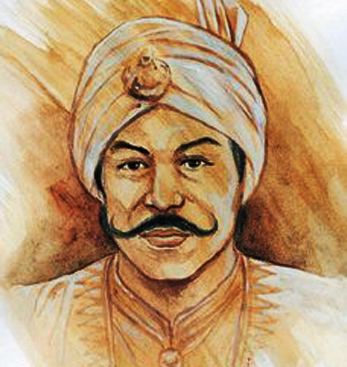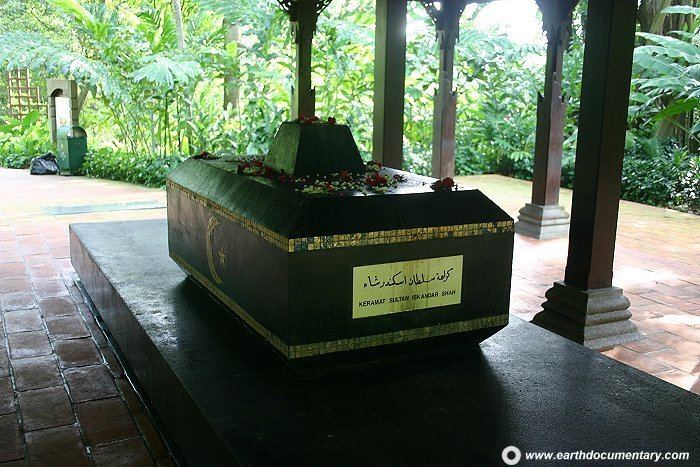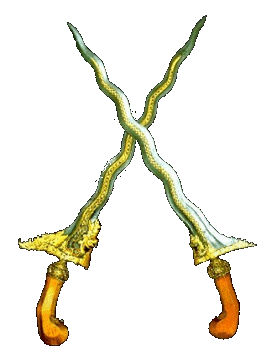Burial Disputed | Role King House Malacca | |
 | ||
Children Megat Iskandar Shah of Malacca Parents Sri Rana Wikrama, Sri Maharaja | ||
Grandparents Paduka Seri Wikrama Wira | ||
Parameswara (1344 – c. 1414), thought to be the same person named in the Malay Annals as Solai Param, was the last king of Singapura. According to the Malay Annals, he ruled Singapura from 1389 to 1398. The king fled the island kingdom after a Majapahit naval invasion in 1398 and founded his new stronghold on the mouth of Bertam river in 1402. Within decades, the new city grew rapidly to become the capital of the Malacca Sultanate. Portuguese accounts, written a hundred years after his death, however suggest he was from Palembang and usurped the throne of Singapura before he was driven out, either by the Siamese or the Majapahit.
Contents
- Etymology
- Origin
- Fall of Singapura
- Foundation of Malacca
- Reign in Malacca
- Conversion to Islam
- Foreign relations with Ming China
- Legacy
- References
Etymology

The name Parameswara is derived from the Sanskrit word Parameśvara (Sanskrit: परमेश्वर), a Hindu concept literally meaning the "Supreme Lord". The word "parama" meaning "the supreme" is added to Ishvara as an intensifier. Parameśvara is also one of the names of Lord Shiva.

There is basically only one record which give in some detail on the kingdoms of Singapura and Malacca - the Malay Annals written during the heyday of Malacca and re-compiled in 1612 by the Johor court. It is the basis for accounts of its founding, the succession of its rulers and its eventual decline. However, the accuracy and historicity of the Malay Annals is in doubt according to historians. Another important record, the Suma Oriental, was written shortly after the Portuguese conquest of Malacca. Both Suma Oriental and Malay Annals do contain similar stories about a fleeing Srivijayan prince arriving in Singapura and about the last king of Singapura who fled to the west coast of Malay peninsula to found Malacca. However, both accounts differ markedly when Suma Oriental identified the fleeing prince and the last king of Singapura as the same person known as "Parameswara". On the other hand, the more detailed Malay Annals identified the fleeing prince and the last king as completely two different persons separated by five generations. Suma Oriental noted further that the fleeing Srivijayan prince usurped the throne of Singapura from a Siamese viceroy named "Temagi" sometimes around the 1390s. The only Chinese first-hand account of 14th century Temasek (the name used before it was changed to Singapura), Dao Yi Zhi Lue written by Wang Dayuan, indicates that Temasek was ruled by a local chief (before the time of Parameswara). However the word used by Wang indicates that the ruler of Temasek was not independent, rather he was a vassal of another more powerful state.

The Ming Chronicle (Ming Shilu) recorded that the consort of Parameswara known as Bā-ér-mí-sū-lǐ (八兒迷蘇里) ('Parameswari') attended a banquet together with the king Bai-li-mi-su-la ('Parameswara') in the Ming court. It is more likely that 'Parameswari' ("Supreme Lordess") referred to a title rather than a given name, which is in fact still in use today in the form of "Permaisuri" ('Queen') in Malay language. Therefore, the name Parameswara is also believed to be a small part of a longer regnal title which was something common among Malay royals until the present day. Apart from Parameswara the founder of Malacca, there were two other rulers from the same lineage that use Parameswara in their regnal title, they are Sang Nila Utama, the founder of ancient Singapura (titled "Sri Maharaja Sang Utama Parameswara Batara Sri Tri Buana") and Abu Syahid Shah, the fourth Sultan of Malacca (titled "Raja Sri Parameswara Dewa Shah").
Origin
There are varying accounts of the origin and life of Parameswara. Although the Malay Annals omits any mention of Parameswara, it is believed that the Iskandar Shah of the Malay Annals may have been Parameswara. In this account, Parameswara would have been a descendant of Sang Nila Utama said to have founded Singapura. However, Portuguese accounts by Tomé Pires and João de Barros that may have been based on a Javanese source suggest that Parameswara was a prince from Palembang who attempted to challenge Javanese rule over Palembang sometime after 1360. In this version, different from that of the Malay Annals, the Javanese attacked and drove Parameswara out of Palembang, who then escaped to Singapore. Parameswara soon assassinated the local ruler with the title Sang Aji, Sangesinga. Parameswara then ruled for five years before he was driven out by people from the Kingdom of Patani, possibly for killing Sang Ali whose wife may have been from Patani. However, the account by Pires indicates that Iskandar Shah was the son of Parameswara who became the second ruler of Malacca. Many scholars believe that Parameswara and Iskandar Shah are the same person, although some argued for Megat Iskandar Shah being the son of Parameswara.
Fall of Singapura
Based on the account from the Malay Annals, Sri Maharaja of Singapura was succeeded by his son, Iskandar Shah, in 1389. Despite the use of the peculiar Persian name and title, there is evidence of his conversion to Islam. Accounts in the Malay Annals trace back the Islamic influence in Singapura to the reign of Sri Rana Wikrama, when he first established relationships with a Sumatran Muslim Kingdom, Peureulak. One source claims that Parameswara had a Muslim woman as his wife and converted to her religion.
As mentioned in the Malay annals, the story of the fall of Singapura and the flight of its last king begins with Iskandar Shah's accusation of one of his concubines of adultery. As punishment, the king had her stripped naked in public. In revenge, the concubine's father, Sang Rajuna Tapa who was also an official in Iskandar Shah's court, secretly sent a message to Wikramawardhana of Majapahit, pledging his support should the king choose to invade Singapura. In 1398, Majapahit dispatched a fleet of three hundred main man of war and hundreds of smaller vessels, carrying no less than 200,000 men. Initially. the Javanese soldiers engaged with the defenders in a battle outside the fortress, before forcing them to retreat behind the walls. The invasion force laid a siege of the city and repeatedly tried to attack the fortress. However the fortress proved to be impregnable.
After about a month, food in the fortress began to run low and the defenders were on the verge of starvation. Sang Rajuna Tapa was then asked to distribute whatever grain left to the people from the royal store. Seeing this opportunity for revenge, the minister lied to the King, saying the stores were empty. The grains were not distributed and the people eventually starved. The final assault came when the gates were finally opened under the order of the treacherous minister. The Majapahit soldiers rushed into the fortress and a terrible massacre ensued. According to the Malay Annals, "blood flowed like a river" and the red stains on the laterite soil of Singapore are said to be blood from that massacre. Knowing that defeat was imminent, Iskandar Shah and his followers fled the island.
Foundation of Malacca
Iskandar Shah or Parameswara fled north to found a new settlement. In Muar, Parameswara contemplated establishing his new kingdom at either Biawak Busuk or at Kota Buruk. Finding that the Muar location was not suitable, he continued northwards. Along the way, he reportedly visited Sening Ujong (former name of present-day Sungai Ujong) before reaching a fishing village at the mouth of the Bertam River (former name of the Malacca River). This evolved over time to become the location of modern-day Malacca Town. According to the Malay Annals, legend has it that the king saw a mouse deer outwitting his hunting dog into the water when he was resting under the Malacca tree. He thought this boded well, remarking, 'this place is excellent, even the mouse deer is formidable; it is best that we establish a kingdom here'. Tradition holds that he named the settlement after the tree he was leaning against while witnessing the portentous event. Today, the mouse deer is part of modern Malacca's coat of arms. The name "Malacca" itself was derived from the fruit-bearing Malacca tree (Malay: Pokok Melaka) scientifically termed as Phyllanthus emblica. Another account on the origin the naming of Malacca elaborates that during the reign of Muhammad Shah (1424–1444), the Arab merchants called the kingdom 'Malakat' (Arabic for 'congregation of merchants') because it was home to many trading communities.
Reign in Malacca
After the foundation of the new settlement in Malacca, Parameswara initiated the development of the place and ordered his men to cultivate the lands with banana, sugar cane, yam and other crops for food. Taking the advantage of the harbour that is protected by a hill and sheltered ships well from the danger of strong tides, Parameswara laid the foundation of a trading port by building the storage and market facilities to serve as a meeting point to exchange goods. The indigenous inhabitants of Malacca and the strait, the Orang Laut, who were also known as the loyal servants of Malay rulers since the time of Singapura and Srivijaya, were said to have been employed by Parameswara to patrol the adjacent seas, to repel other petty pirates, and to direct traders to their Malay overlords' port. Ironically, Orang Lauts themselves were known to be ferocious pirates in history. Within years, news about Malacca becoming a centre of trade and commerce began to spread all over the eastern part of the world and reached as far as China. The Yongle Emperor of the Ming dynasty, who reigned from 1402 till 1424, sent his envoy known as Yin Qing to Malacca in 1405. Yin Qing's visit opened the way for the establishment of friendly relations between Malacca and China. Chinese merchants began calling at the port of Malacca, joining other foreign traders notably the Javanese, Indians, Chinese, and Burmese who came to establish their trading bases and settle in Malacca, soaring its population to 2000 during Parameswara's reign.
In 1411, Parameswara, his wife, his son, and a royal party of 540 people left for China with Admiral Zheng He to pay homage to the Yongle Emperor. Yongle praised Parameswara and acknowledged him as the rightful ruler of Malacca. He then presented Parameswara with a seal, silk and a yellow umbrella as symbols of royalty and also a letter appointing Parameswara as the ruler of Malacca. Malacca was then recognised as a kingdom by the Emperor of China. The envoy returned to Malacca together with a fleet led by Zheng He.
The Chinese chronicles mention that in 1414, the son of the first ruler of Malacca visited Ming China to inform them that his father had died. It is generally believed that he was buried on top of a hill at Tanjung Tuan (also known as Cape Rachado), near modern-day Port Dickson. Parameswara was succeeded by his son, Megat Iskandar Shah who in turn ruled Malacca until 1424.
Conversion to Islam
It was generally believed that in the year 1409, he married a princess of Pasai and adopted the Persian title Iskandar Shah after his conversion to the faith. The Malay Annals suggests that he used the Persian title Iskandar Shah since his reign in Singapura in the 1390s. The text further noted that the Islamic influence in Singapura traced back to the reign of Sri Rana Wikrama who established ties with the Sumatran Muslim kingdom, Peureulak and there was even a presence of an ulama from Pasai in Singapura during the reign of his successor, Sri Maharaja. The 16th-century Portuguese author Tomé Pires specifically noted that Parameswara was succeeded by his son, referred to as Chaquem Daraxa or Iskandar Shah. According to Pires, it was Iskandar Shah who converted to Islam at the age of 72. Nevertheless, the Malay Annals noted that it was during the reign of the third ruler Muhammad Shah that the ruling class and the subjects began to convert to Islam. While there are differing views on when the Islamisation of Malacca actually took place, it is generally agreed that Islam was firmly established by the reign of Muzaffar Shah.
Foreign relations with Ming China
The relation with Ming China started in the early 15th century when Parameswara embarked on several voyages to visit the Yongle Emperor. In 1403, the first official Chinese trade envoy led by Admiral Yin Qing arrived in Malacca. Later, Parameśwara was escorted by Zheng He and other envoys in his successful visits. Malacca's relationships with Ming granted protection to Malacca against attacks from Siam and Majapahit and Malacca officially submitted as a protectorate of Ming China. This encouraged the development of Malacca into a major trade settlement on the trade route between China and India, Middle East, Africa and Europe.
In 1411, Parameswara and his wife together with 540 officials from Malacca went to China to pay homage to the Yongle Emperor (r. 1402–1424). Upon arriving, a grand welcoming ceremony was held with sacrification of animals. The historical meeting between Parameswara and the Yongle Emperor was recorded accurately in the Ming chronicle:
Tributes that Malacca paid to Ming included: agate, carnelian, pearl, hawksbill, coral, crane beak, golden female crane beak, suit, white cloth, Western fabric, Sa-ha-la, rhino horn, ivory, black bear, black ape, white muntjac, turkey, parrot, pian-nao, rosebush dew, su-he oil, gardenia flower, wu-ye-ni, aromatic wood, incense sticks, gold silver incense sticks.
Legacy
Within decades after its foundation, Malacca grew into an international trading port and heralded the golden age of Alam Melayu. 80 languages were reportedly spoken in Malacca. Malacca became an important port in the far east during the 16th century. It became so rich that the Portuguese writer and trader Tome Pires said "Whoever is lord of Malacca shall have his hands on the throat of Venice." The new Malay sultanate emerged as the primary base in continuing the historic struggles of its predecessors, Singapura and Srivijaya, against their Java-based nemeses. By the mid-15th century, Majapahit found itself unable to control the rising power of Malacca that began to gain effective control of Malacca straits and expands its influence to Sumatra. The Malay Annals records that, at the height of its power, following the accession to the throne of Sultan Mansur Shah in 1459, Malacca's territory covered much of the Malay peninsula as well as the Riau-Lingga islands and parts of the east coast of Sumatra namely Indragiri, Kampar, Siak, Rokan, Haru and Siantan. Malacca was still looking to expand its territory as late as 1506 when it conquered Kelantan.
The prosperity of Malacca as an international port changed the entire Maritime Southeast Asia and its success was admired by kings from neighbouring kingdoms. As a major entreport, Malacca attracted Muslim traders from various part of the world and became a centre of Islam, disseminating the religion throughout the Maritime Southeast Asia. The process of Islamisation in the region surrounding Malacca gradually intensified between the 15th and 16th centuries through study centres in Upeh, the district on the north bank of the Malacca River. Islam spread from Malacca to Jambi, Kampar, Bengkalis, Siak, Aru and the Karimun Islands in Sumatra, throughout much of the Malay peninsula, Java and even Philippines. The Malay Annals even reveals that the courts of Malacca and Pasai posed theological questions and problems to one another. Of the so-called Wali Sanga ('nine saints') responsible in spreading Islam on Java, at least two, Sunan Bonang and Sunan Kalijaga, are said to have studied in Malacca. The expansion of Islam into the interiors of Java in the 15th century led to the gradual decline of Malacca's long standing foe, Hindu-Majapahit, before it finally succumbed to the emerging local Muslim forces in the early 16th century. Ultimately, the period spanning from Malaccan era right until the age of effective European colonisation, saw the domination of Malay-Muslim sultanates in trade and politics that eventually contributed to the Malayisation of the region.
